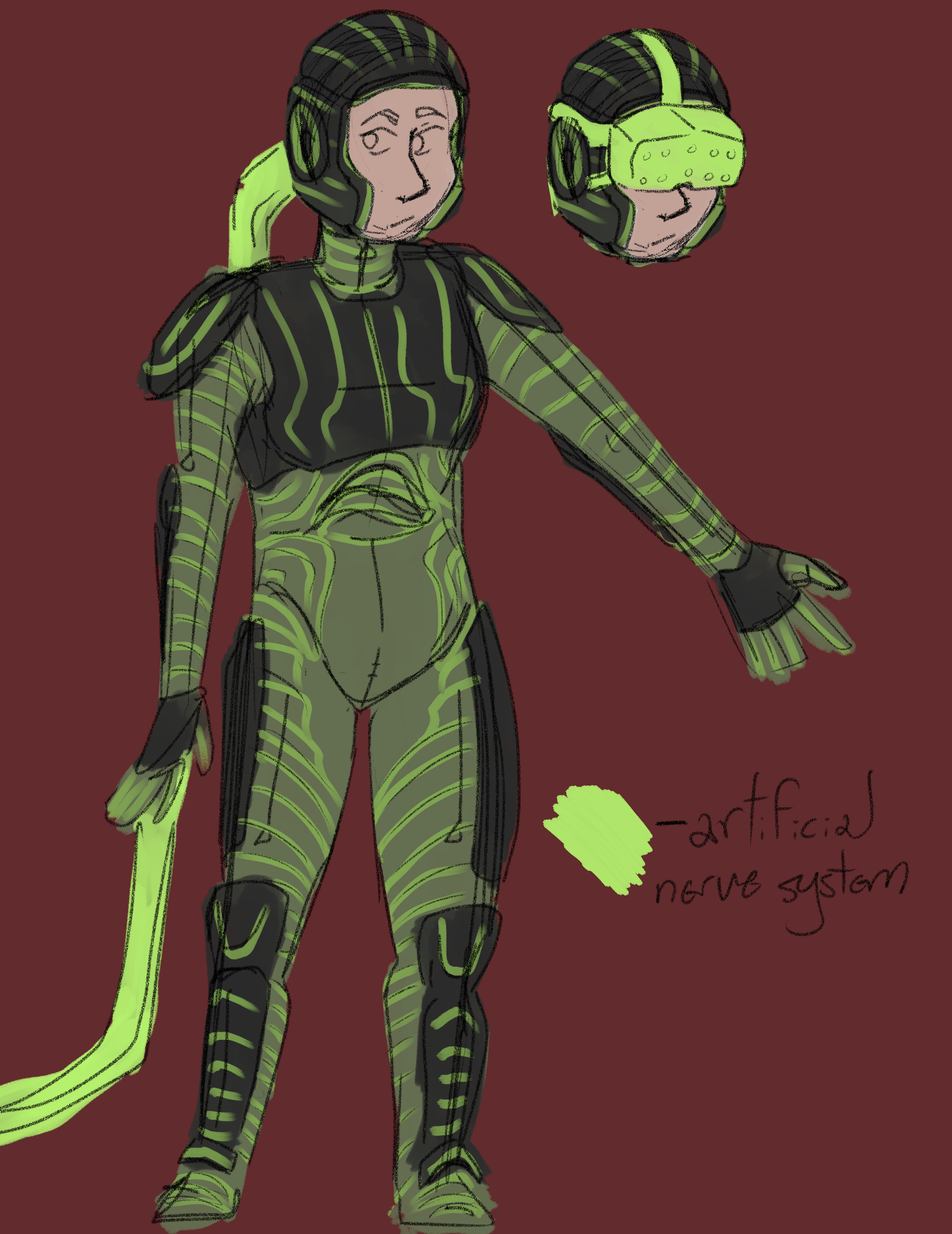HaFSRS: Haptic Feedback and Sensory Relay Suit
Sounding like something straight out of a sci-fi series, the HaFSRS (half-serz) is a type of lightly armored jumpsuit or flightsuit worn by "dynamos," the human components, to tether to their "charges," or "baluns," their assigned MAI.
Utility
In the most recent and standard iteration, the HaFSRS suit links multiple senses between the charge and dynamo, most simply, the main four are touch, orientation, sight, and hearing.
The touch aspect is the most prominent characteristic of the HaFSRS suit, hence "Haptic" being within its title. When a dynamo is tethered to their charge, any physical sensation experienced by one will be transmitted to the other through a fiber optic umbilical that attaches from the helmet to the AI core. Physical sensation will be expressed by the HaFSRS in several ways: vibration, compression, or TENS (Transcutaneous Electrical Nerve Stimulation), or that is to say for the latter, via electroshock. The average person may wince at such a concept, but pain transmission is critical for a charge/dynamo pair while in combat for the most accurate transmission of health and condition data. During trials for the suit before TENS transmission was implemented, dynamos often struggled to differentiate between a hard knock on their balun's structure, and the simulation of a damaging enemy projectile. In the realm of active combat, understanding the severity of damage to the hull can be the difference between life and death.
Focusing on vibration and compression, these are the transmission methods used for standard, benign contact with the charge's structure. The most difficult part of refining this technology was actually the mapping of an MAI's structure to the body of their human dynamo. Thinking for a moment, which part of a tank would you equate to your chest? The back of your leg? Your shoulder blades? These were questions that had to be not only answered by a fairly large focus group of prospective dynamos and baluns, but separately adjusted to every hull or fuselage style that would be employing the tech.
Moving on to the orientation aspect, the HaFSRS suit employs several types of sensors to supply orientation data to the charge: complex proximity detectors, force transducers, gyros, and compasses. The proximity detectors are placed in multiple locations throughout the suit to measure distances between different parts of the body, and internal gyros and magnetic compass systems deduce the angle and orientation of said limbs to simulate proprioception from the dynamo to the charge. Force transducers are also useful during high-activity maneuvers to accurately measure the gravitational forces that are exerted upon both the dynamo and charge.
In comparison to the previously mentioned systems, the sight system sounds almost rudimentary in comparison, but it's not without its own advantages. The setup itself is fairly simple from the outside, not appearing to be much more than an AR headset, and that’s not exactly far from the truth. The headpiece is able to be freely removed by the dynamo at any time and is the only part of the HaFSRS that is essentially auxiliary and separate from the rest of the suit. Donning the headpiece, it is by default set to display the view of one of the charge’s dominant optics, but to change this, this is where some technology specific to the HaFSRS headset comes into play. In order to offer touchless use, the headpiece utilizes a pupil tracking program that is able to track where the wearer is looking on the visual display. In the peripherals of the interior screen are settings to change the POV from which the dynamo is seeing, and to select these alternate settings, they only must look at the desired viewpoint to switch over to it. On top of being able to change which of the charge’s optics they are looking out of, they can also choose to look out of the cameras on the front of the headpiece, so that they may see from their own point of view while not having to remove the headpiece.
Last, but just as important as any other system of the HaFSRS, is the hearing component. This system carries out two main functions: shared hearing, and voice transmission. Starting with hearing, this system operates by tapping into the balun’s own external and internal aural processing units, and sends these signals, along with their directional data, to the dynamo. To an unaware user, this system may seem like it functions than little more than a headset with left-right directional audio, but there’s an additional feature that makes them far more advanced. Think of a cat for a moment – no, seriously! – whenever they pick up a curious new sound, they turn their ears to face it. The muscles that exist in and around the ears of these small quadruped compatriots actually still exist in humans, although they tend to be vestigial and atrophied in comparison. Their existence at all, however, is what allows the HaFSRS earpiece to function. When a person hears a sound of interest, these muscles will actually act accordingly, although its so subtle in the average person that it’s hard to see – thing is, the earpiece only needs to detect the electrical signal within the muscles in order to work.
When an array of sensors within the cups of the earpiece detect minute electrical signals from the muscles, it can deduce the intended direction of focus, and will apply this data to the directional data from the balun. Using the data on the direction of focus, and the directional data of the incoming audio signals, the system will then go on to amplify the audio from the desired source, and will temporarily attenuate audio data from all other directions. This is a method with which a dynamo may take advantage of the advanced hearing range of their charge, while not being overwhelmed by the brunt of the raw audio data.
Social Impact
The bond between a dynamo and their balun is often incredibly close, given the wealth of intimately shared experiences that they often go through. This relationship will occasionally go so far as to being romantic in nature, but more often than not, the relations of an ampere are often less described as a relationship between two individuals, and more often as one that is experienced as two halves of a singular self. The connection may begin as standard camaraderie at first, but after prolonged utilization of the technology, many amperes may go so far as to discontinue thinking of themselves as two separate individuals, and replace that concept with the idea that they have become extensions of the self to one another.
This type of intensely close bond is the reason that amperes were eventually given the ability to purchase their suits on loan from the alliance. Although not always, some balun/dynamos became so close throughout their active service that being apart for extended periods of time had become greatly distressing – many of the affected described it as though they had lost a fundamental part of themselves when they couldn’t tether to their other halves. Some dynamos and charges, due to this feeling, began to claw at opportunities to extend the length of their active service to the armed forces since it was the only way that they could ensure their access to their HaFSRS. Otherwise, upon the completion of service, the suit was relinquished to be recycled or repurposed.
In older times, one might scratch their head at the prospect of wanting to stay in the service being a bad thing, and historically speaking, they probably weren’t wrong. Under the Livastian Alliance, however, this is a different story. Perhaps in times of war, simply having as many capable bodies – or even bodies at all – as possible was the best case scenario, but the war had long since ended. In the following decades of peace, drastic changes to the global political climate, and handing of affairs, near all countries of the Livastian Alliance opted to lean out their forces and shift priorities away from simply having “a lot of bodies.” No longer needing to be at each others’ throats, militaries now prioritize having only the most dedicated, able-bodied and passionate service members to occupy their forces. For charge/dynamo pairs, the dedication was certainly there, but the reasoning behind it wasn’t exactly… healthy.
Fortunately or unfortunately, a situation such as this was almost predicted by members of the design team behind the HaFSRS, although nothing as extreme as what it had turned out to be. In a series of talks with the Alliance and other associated parties, it was eventually agreed upon that dynamos and baluns would be granted the ability to pay to bring home their fittings on loan – under a heavy list of stipulations, which most accepted with little question.
Access & Availability
In the earliest of their development stages, HaFSRS suits were incredibly rare. Throughout the experimental trial periods of the late 90s, only 20 suits of varying complexity were ever made, and only 10 MAI were ever created with compatibility to them. When development was recontinued in the 2020s and the first designs were greenlit for use in the 2030s, however, they became almost standard to at least be compatible with all MAI produced thereafter. As the situation currently stands, these suits are only available to those who participated in active military service, but even then, they are allowed to be kept by servicemembers after they're relieved of duty.
Related Species






Comments